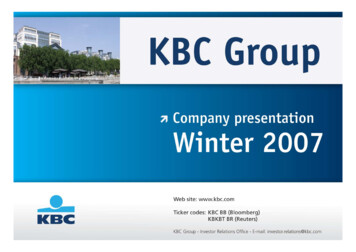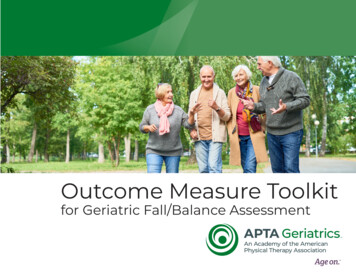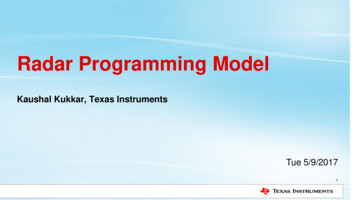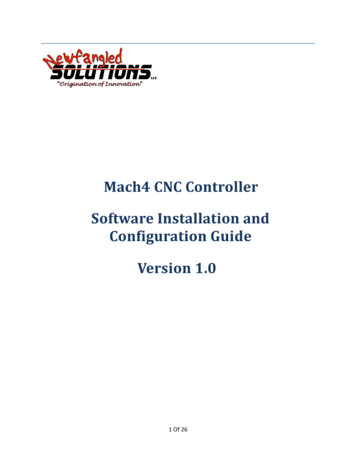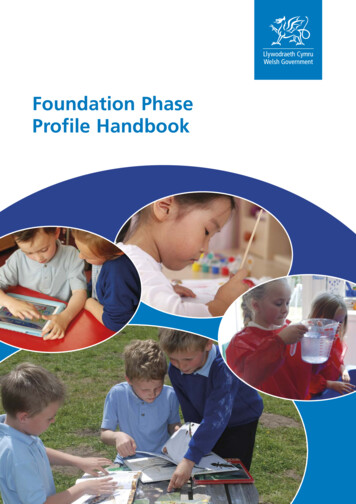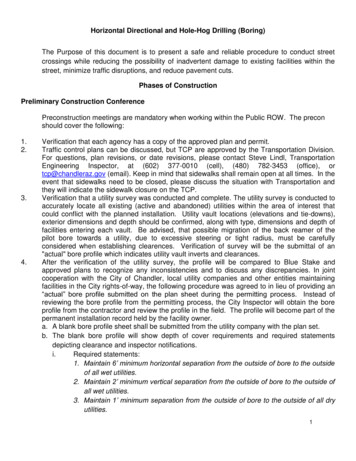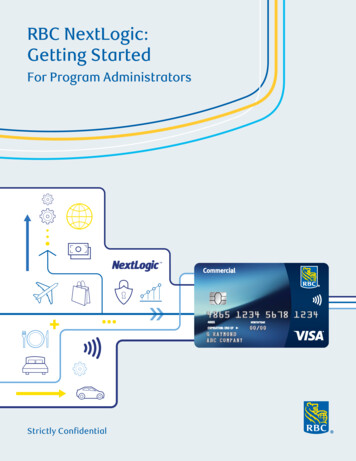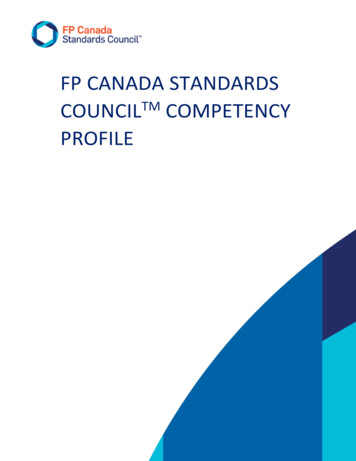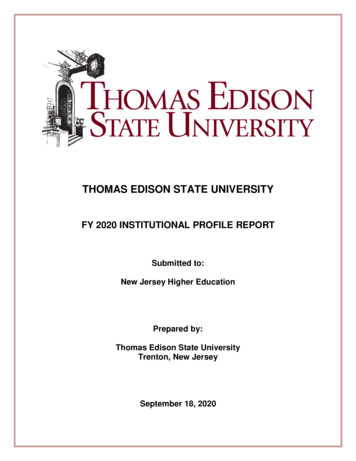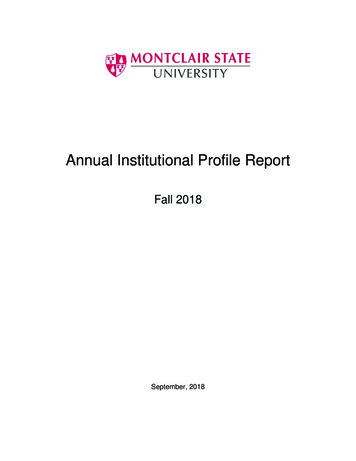
Transcription
Annual Institutional Profile of Montclair State University, 2020Annual Institutional Profile ReportFall 20201
Annual Institutional Profile of Montclair State University, 2020PREFACEFounded as the New Jersey State Normal School at Montclair in 1908, Montclair StateUniversity today is a preeminent center of research, education, and scholarship. TheUniversity offers a broad array of undergraduate and graduate programs in the liberal artsand sciences, as well as in the professional fields of business, communication and media,healthcare, the arts, and education. Substantial growth in research activity anddoctoral-level education has earned Montclair State designation by the State of New Jerseyas a public research university, and by the Carnegie Classification of Institutions of HigherEducation as a national research doctoral university (R2, high research).Montclair State continues on its course of significant growth and development with anenrollment of 21,000 students, new programs, new faculty, and expanding physical facilities.Recent accomplishments include the opening of the Center for Computing and InformationScience, the founding of University College, the opening and expansion of the School ofNursing, and construction of state-of-the-art learning and research facilities for students inthe Feliciano School of Business, College of Science and Mathematics, and School ofCommunication and Media. Faculty have won numerous awards including, NSF CAREERgrants and a MacArthur Foundation “Genius” grant. In fall 2020, the University will open thecompletely renovated original campus building, College Hall, to be repurposed as the newcentralized location for all student services. In response to the Governor’s Executive Order175, allowing the reopening of higher education institutions during the pandemic, MontclairState offered a mix of online, hybrid and face-to-face instruction for fall 2020. The Universitymet the Federal criteria for recognition as an Hispanic-Serving Institution, and serves aminority-majority student population with more than half of its entering class each year beingstudents of color. These activities are evidence of the University’s commitment to steadilyadapting and evolving to serve the educational needs of New Jersey, grounded in a missionof academic excellence and service. The University’s full mission statement follows.2
Annual Institutional Profile of Montclair State University, 2020Institutional MissionMontclair State University is committed to serving the educational needs of New Jersey withprograms characterized by academic rigor and currency in the development of knowledge andits applications. The University will offer a comprehensive range of baccalaureate, master’s andcertificate programs and a focused portfolio of doctoral programs that are closely aligned withthe University’s academic strengths and the needs of the state.The University will recruit faculty with exceptional academic or professional credentials and adeep commitment to the pursuit of their development as teachers and scholars. The Universitywill admit to study with this faculty, students who have demonstrated the potential for highachievement, diligence in the pursuit of their education, and high aspirations for using theireducation. The University will be inexorably committed to the maintenance of a learningcommunity that is deeply and broadly reflective of the diverse population of New Jersey.All University programs will develop in students the ability to discover, create, evaluate, apply,and share knowledge in a climate characterized by tolerance and openness in the exploration ofideas. Curricular and co-curricular programs will cultivate the ability to think critically, to actethically, and to become informed citizen-participants prepared to assume leadership roles in ademocracy. Recognizing the increasing connectedness of the world, the University will ensurethat all students develop an understanding of global issues and of their responsibilities ascitizens of the world.The University will serve as a center for the creation of new knowledge and for the developmentof innovative applications of existing knowledge and as a center for pedagogical and artisticexcellence and creativity. The University seeks to focus the professional activities of its facultyand the educational endeavors of its students on the enduring disciplines that will continue toconstitute the knowledge base of an educated citizenry in the 21st century, as well as on themore specific and changing areas of study that have particular relevance to the region served bythe University.The University will play a role beyond the campus community, partnering and collaborating atthe local, state, national and international levels to make positive contributions to addressingissues of importance to society, to enable students to experience their ability to use knowledgein constructive ways in the world, and to share the rich array of intellectual and culturalresources of the University with the people of New Jersey.Dr. Susan A. ColePresidentMontclair State University3
Annual Institutional Profile of Montclair State University, 2020ContentsData by CategoryA. Accreditation Status B. Number of Students Served C. Characteristics of Undergraduate Students D. Student OutcomesE. Faculty CharacteristicsF. Characteristics of the TrusteesG. A Profile of the InstitutionH. Major Research and Public Service ActivitiesI. Major Capital ProjectsAppendix – University Authors45589141719202527
Annual Institutional Profile of Montclair State University, 2020DATA BY CATEGORYA. Accreditation StatusMontclair State University is accredited by the Middle States Commission on HigherEducation, 3624 Market Street, 2 nd Floor West, Philadelphia, PA 19104. Programsleading to a degree or certificate (not certification) are approved by the Office of theSecretary of Higher Education of the State of New Jersey. Programs leading to NJ Statecertification are approved by the New Jersey Department of Education using thestandards of the National Association of State Directors of Teacher Education andCertification.Discipline-specific accreditations include: AACSB International The Association to Advance Collegiate Schools ofBusiness (Baccalaureate and Graduate degree programs in business, School ofBusiness) ACEND - Accreditation Council for Education in Nutrition and Dietetics of theAcademy ofNutrition and Dietetics (Didactic Program in Dietetics, Baccalaureate level; DieteticInternship, Department of Health and Nutrition Sciences) CAATE - Commission on Accreditation of Athletic Training Education (AthleticTraining major, BS, Department of Exercise Science and Physical Education,College of Education and Human Services) CAC/ABET - Computing Accreditation Commission of the Accreditation Board forEngineering and Technology (ABET) (Computer Science major, concentration inProfessional Computing, BS, Department of Computer Science, College ofScience and Mathematics) CACREP - Council for the Accreditation of Counseling and Related EducationPrograms (Counseling, Ph.D., Counseling, M.A., Department of Counseling andEducational Leadership,College of Education and Human Services) CAA/ASHA - Council on Academic Accreditation in Audiology andSpeech-Language Pathology of the American Speech Language HearingAssociation (ASHA). CAA has accredited the M.A. with concentration inSpeech-Language Pathology; and the Doctoral program in Audiology (AuD) inthe Department of Communication Sciences and Disorders, College ofHumanities and Social Sciences5
Annual Institutional Profile of Montclair State University, 2020 CAEP – Council for the Accreditation of Educator Preparation [Formerly NCATE] for programs preparing elementary and secondary school teachers, as well asadministrative and school service personnel CCNE – Commission on Collegiate Nursing Education (BSN in Nursing, Schoolof Nursing) CEPH - Council on Education for Public Health. (Master of Public Health (MPH),BS in Public Health, concentration in Community Health Education, Departmentof Public Health, College of Education and Human Services CSWE - Council on Social Work Education (Master of Social Work Program,Department of SocialWork and Child Advocacy, College of Humanities and Social Sciences) NASAD - National Association of Schools of Art and Design (Fashion Studiesmajor, BA; Fine Arts major, concentrations in Art Education, Art History, StudioArt, BA; Animation/Illustration major, Filmmaking major, Fine Arts/Studio major,Graphic Design major, Industrial Design major, BFA; Studio Art major, MFA;Department of Art and Design, College of the Arts) NASD - National Association of Schools of Dance (Dance major, concentrationDance Education,BA; Dance major, BFA, Department of Theatre and Dance, College of the Arts) NASM - National Association of Schools of Music (Music Therapy major, BA;Music major, concentrations in Music Education, Jazz Studies, Performance,Theory/Composition, BMus; Music major, concentrations in Music Education,Music Therapy, Performance, andTheory/Composition, MA, John J. Cali School of Music, College of the Arts) NAST - National Association of Schools of Theatre (Theatre Studies major, BA;Theatre major concentrations in Acting and in Production/Design, BFA; Theatremajor with concentration in Arts Theatre Studies, MA, Department of Theatre andDance, School of the Arts)Program approvals include: American Alliance for Health, Physical Education, Recreation, and Dance(AAHPERD)/American Association for Health Education (AAHE): HealthEducation major, BS, initial teacher certification, P-12American Alliance for Health, Physical Education, Recreation and Dance(AAHPERD)/National Association for Sport and Physical Education (NASPE):Physical Education major, BS, initial teacher certification, P-12American Bar Association: Justice Studies major, Paralegal Studiesconcentration, BA. Paralegal Studies minor; Post-baccalaureate CertificateProgram in Paralegal Studies6
Annual Institutional Profile of Montclair State University, 2020 American Chemical Society: Biochemistry major, BS; Chemistry major, BS.Chemistry minor; Chemistry major, MS; Chemistry major, Biochemistryconcentration, MSAmerican Music Therapy Association: Music Therapy major, BA; Music major,concentration in Music Therapy, MACouncil for Exceptional Children: Early Childhood Special Education major, MEd;Learning Disabilities major, MEd; Learning Disabilities Teacher-Consultant,post-master’s certification; Communication Sciences and Disorders major,concentration in SpeechLanguage Pathology, MAEducational Leadership Constituent Council (ELCC): Educational Leadershipmajor, MAInternational Reading Association (IRA): Reading major, MA; Reading Specialist,postbaccalaureate educational services certification, P-12National Association for the Education of Young Children (NAEYC): Family andChild Studies major, concentration in Early Childhood, BA, initial teachercertification, P-3National Association for Music Therapy: Music Therapy major, BANational Council for the Social Studies (NCSS): Anthropology major, BA, initialteacher certification, P-12; History major, BA, initial teacher certification, P-12;Political Science major, BA, initial teacher certification, P-12; Sociology major,BA, initial teacher certification, P-12; Geography major, BA, initial teachercertification, P-12; Economics major, BA, initial teacher certification, P-12; SocialStudies,MAT, initial teacher certification, P-12; Social Studies,post-baccalaureate teacher certification, P-12National Council of Teachers of English (NCTE): English major, BA, initialteacher certification, 6-12; English, MAT, initial teacher certification, 6-12;English, post-baccalaureate teacher certification, 6-12National Council of Teachers of Mathematics (NCTM): Mathematics major (BS),initial teacher certification, 6-12; Mathematics, MAT, initial teacher certification,6-12; Mathematics, post-baccalaureate teacher certification, 6-12Teachers of English to Speakers of Other Languages (TESOL): Linguistics majorBA, initial teacher certification, P-12; Teaching English as a Second Language,MAT, initial teacher certification, P-12; Teaching English as a Second Language,post-baccalaureate teacher certification, P-12Memberships include: American Association for Colleges for Teacher EducationAmerican Association for Paralegal EducationAmerican Association of Collegiate Registrars and Admissions OfficersAmerican Council on EducationAssociation for Gerontology in Higher EducationAssociation of Public and Land-Grant UniversitiesCouncil of Graduate SchoolsMiddle Atlantic Association of Colleges of Business AdministrationNational Association of Graduate Admissions ProfessionalsNational Association of Student Personnel AdministratorsNational Network for Educational Renewal7
Annual Institutional Profile of Montclair State University, 2020 New Jersey Association of Colleges for Teacher EducationNorth American Association of Summer SessionsNortheastern Association of Graduate SchoolsThe Association to Advance Collegiate Schools of Business8
Annual Institutional Profile of Montclair State University, 2020B. Number of Students ServedFall 2019 UndergraduatesIn fall 2019, 16,687 undergraduates enrolled at Montclair State University, up from14,139 in fall 2009. This is a 18% increase in the past decade (see Table II.B.1).Table II.B.1: Undergraduate Enrollment byAttendance Status, Fall Fall 2019 Graduate StudentsMontclair State University enrolled 4,320 graduate students in fall 2019, up from the4,032 in fall 2009 (see Table II.B.2). The graduate enrollment increased 7% in the pastdecade.Table II.B.2: Graduate Enrollment byAttendance Status, Fall ,320The proportion of graduate students studying full-time has risen over the past decade.The percent of graduate students enrolled full-time rose 9%, from 27% in fall 2009 to36% in fall 2019.9
Annual Institutional Profile of Montclair State University, 2020FY20 (12-Month) Unduplicated EnrollmentsWhile most students are admitted and enrolled at the beginning of each academic year,thousands of additional students enroll during the University’s other sessions that run inthe winter, spring, and summer. During FY20, over 24,000 students attended MSUduring one or more of its academic sessions (see Table II.B.4).Table II.B.4: Unduplicated Enrollment, FY20 (IPEDS 9481,93816,065Graduate5,17664,4612,686Professional Practice501,52163Total24,235547,91918,81410
Annual Institutional Profile of Montclair State University, 2020C. Characteristics of The StudentsFall 2019 First-time UndergraduatesA total of 12,729 individuals applied for admission as first-time undergraduates toMontclair State University in fall 2019, down 5.5% from fall 2009. The Universityadmitted 76.3% of these applicants, and 3,101 of those who were admitted to theUniversity enrolled as first-time undergraduates for a yield of 31.9%.Fall 2019 first-time undergraduates entered MSU as either regular admits, specialadmits, or students admitted through the Educational Opportunity Fund (EOF) program.By admitting students using different admissions categories, the University fulfilled thehopes and aspirations of more of its applicants. Of MSU’s 3,101 first-timeundergraduates, 95% were Regular Admits, 4% were admitted through the EOFprogram, and 1% were Special Admits (see Table II.C.1).In fall 2015, Montclair State became the first public university in New Jersey to adopt anACT/SAT test optional policy. The decision was based upon studies showing that SATand ACT test scores were less effective predictors of college success than studentperformance in high school courses. Test scores are considered if students voluntarilychoose to submit them, but applicants are neither hindered nor advantaged bystandardized test scores alone.Montclair State’s test optional policy is designed to ensure that students selected foradmission are capable of succeeding in the University’s rigorous academic programs. Italso supports the University’s mission to serve a student body that reflects New Jersey’ssocio-economic and ethnic diversity.A total of 1,357 (44%) of MSU’s first-time undergraduates voluntarily submitted SATscores to the University. Table II.C.1 contains information on Math and Evidence-basedReading and Writing scores submitted by first-time undergraduates.TABLE II.C.1: Mean Math, Reading & Writing SAT for First-Time Freshmen, byAdmission Status and Overall, Fall RWNumber Math Number ERW1,2775391,277EOF5749257504 ****Special1656716541 545507712549549
Annual Institutional Profile of Montclair State University, 2020In fall 2019, Montclair State University did not offer any remedial courses.Table II.C.2: Enrollment in Remedial Courses/Degree-seeking students,Fall 2019Total Fall 2019 UndergraduateEnrollmentNumber of StudentsEnrolled in One orMore RemedialCoursesPercent ofTotal16,47700.00%Total Number of Full-time,First-time StudentsNumber of FTFTStudentsEnrolled in One orMore RemedialCoursesPercent ofFTFTStudentsEnrolled inOne or MoreRemedialCourse3,08200.00%Remedial Subject AreaNumber of FTFTStudents Enrolled inPercent ofFTFTStudentsEnrolled inReading00.00%Writing00.00%Math Computation00.00%Elementary Algebra00.00%A CIRP survey administered to fall 2019 first-time undergraduates revealed that 90%considered MSU to be their first or second choice among colleges. The survey alsorevealed that the top four reasons freshmen chose MSU were: a) very good academicreputation (62%), b) good reputation for social and extracurricular activities (57%) c)affordability (60%), and d) a visit to the campus (52%). The Freshman Survey (CIRP) isrun every three years.12
Annual Institutional Profile of Montclair State University, 2020The profile of the fall 2019 entering class reflects the continuing commitment of theUniversity to an ethnically and racially diverse student body. Among all first-timeundergraduates, 14.3% identified themselves as African American, 6.9% as Asian,30.6% as Hispanic/Latinx, and 3.7% as belonging to two or more races. Femalescomprised 63.7% of all first-time undergraduates.Fall 2019 UndergraduatesIn fall 2019, a total of 21,007 students attended Montclair State University. Of this total,16,687 (or about 80% of all enrollees) were registered as undergraduates. The numberof undergraduates attending the University rose 8.5% between fall 2009 and fall 2019.About 89% of fall 2019 undergraduates attended the University full-time, up 23percentage points from fall 2009. MSU’s full-time undergraduate population wasdiverse, with 30% of undergraduates identifying themselves as Hispanic/Latinx, 14% asAfrican American, 6% as Asian, and 40% White.(see Table II.C.3.a & notes).TABLE II.C.3.a: Undergraduate Enrollment by Race/Ethnicity, Fall ent Number PercentNative American180.12%30.16%210.13%African 32%Non-Resident Alien 1,2107.25%Total14,859100%1,828100%16,687100%* Includes Native Hawaiian and Other Pacific Islander.** Includes Two or More Races.13
Annual Institutional Profile of Montclair State University, 2020In fall 2019, 61% of all undergraduates were female, and the average age of theundergraduate population was 21.59 years (see Tables II.C.3.b and II.C.3.c).TABLE II.C.3.b: Undergraduate Enrollment by Sex, Fall 59100%1,828100%16,687100%TABLE II.C.3.c: Undergraduate Enrollment by Age, Fall entNumberPercentLess than 50.17%713.88%960.58%More than %UnknownTotalDuring AY18-19, MSU’s undergraduates received financial aid from Federal, State,University, and private sources. Aid took multiple forms, from grants and scholarships,through loans and waivers. For those who needed financial assistance, the MSU AlumniAssociation and the MSU Foundation sponsored a number of scholarships, and special14
Annual Institutional Profile of Montclair State University, 2020MSU program awards were substantial, amounting to more than 10 million duringthe award year. Also in AY18-19, Federal grants, loans, and work-studyprograms amounted to over 124 million.MSU distributed an additional 40 million in state-funded financial aid during AY18-19,including both scholarships and NJCLASS loans (see Table II.C.4). A total of 7,499State awards were made to MSU students, including 6,475 TAG Awards, 285 NJCLASSLoans, and 643 EOF Awards.Table II.C.4: Financial Aid from Federal, State & Institution-Funded Programs,AY18-19Recipients Dollars /RecipientSTATE PROGRAMSTAG6475344140005320EOF6438110001261NJ Stars II Scholarship571170002053Urban 817150001231SEOG15871109000699Stafford Loans (Subsidized)8294337880004074Stafford Loans (Unsubsidized)8215282690003441PLUS Loans169423439000138363970112960002845NJCLASS LoansFEDERAL PROGRAMSPell GrantsCollege Work StudyINSTITUTIONAL PROGRAMSGrants/Scholarships15
Annual Institutional Profile of Montclair State University, 2020Of MSU’s 3,101 first-time undergraduates who entered in fall 2019, 94% were NewJersey residents (see Table II.C.5). Most were from Bergen (507), Passaic (480), andEssex (478) counties.Table II.C.5: First-Time Undergraduate Enrollment by State of Residence,Fall 2019State Residents2,924Non-State Residents177TotalStudents3101% StateResidents94.29%Fall 2019 Graduate StudentsOf the 21,007 students who attended Montclair State University in fall 2019, 4,320(20.5%) were graduate students. Graduate student enrollment rose 7.1% between fall2009 (4,032) and fall 2019 (4,320).Most graduate students (64.2%) attended MSU part-time, taking fewer than nine creditsper semester. Nearly 71% of fall 2019 graduate students were female, and the averageage of the graduate student population was 31.09 years. Among Montclair StateUniversity’s graduate students, 10.7% of graduate students identified themselves asAfrican American, 5.8% as Asian, 17.4% as Hispanic/Latinx, 54% as White, 4.5% asnon-resident aliens, and 1.7% as multi-racial. Of MSU’s 4,320 graduate students, 91.1%are New Jersey residents.16
Annual Institutional Profile of Montclair State University, 2020D. Student OutcomesSixty-seven percent of all full-time, first-time freshmen who entered MSU in the fall of2013 earned a degree within six years of entry (see Table II.D.1.a).TABLE II.D.1.a: Four-, Five-, and Six-Year Graduation Rates of Fall 2013 Full-Time,First-Time Freshmen by Race/EthnicityGraduatedwithin 5yearsGraduatedin 4 yearsNumberAfrican AmericanCohort 293Percent NumberGraduatedwithin 6yearsPercent NumberPercent116401796119767Asian Cohort 1737141975610963Latinx Cohort 683262384086044765White Cohort 8265196701,350451,896632,02967Non-Resident AlienCohort 43Two or More Races 114Unknown Cohort 279Total Cohort 3,027Over 80% of all full-time, first-time undergraduates who entered MSU in fall 2018returned in fall 2019 (see Table II.D.2).TABLE II.D.2: First Year Retention of First-Time Undergraduates, Fall 2018 to 2019Original PercentFull-time3,1682,538 80.11%63019.89%Part-time3113 41.94%1858.06%3,1992,551 79.74%64820.26%Total17
Annual Institutional Profile of Montclair State University, 2020Transfer Student OutcomesOf the 1,277 students who entered MSU as full-time transfer students in fall 2013,60.5% earned their degrees within three years, 73.1% earned degrees within four years,and 74% earned degrees within six years. The one-year retention rate for full-timetransfer students who entered in fall 2018 was 84.3%.Other Student OutcomesUsing data from the National Student Clearinghouse, 2,784 alumni who earnedBachelor’s degrees in 2009-10 were tracked over a 10-year period to determine howmany had furthered their education by enrolling in graduate school. The analysisrevealed that 1,178 (42.3%) of these alumni continued their formal education, and ofthose who continued their education, 751 (27%) earned one or more graduate degrees,including 77 doctorates and 721 Master’s degrees.University assessment efforts are led by the Committee on University Effectiveness(CUE). During the past years, on a three-year cycle, CUE has collected student learningoutcome goals, information on assessment methods, and assessment data fromacademic departments related to learning in the major, and assessed student learningin general education using the collegiate Learning Assessment Plus (CLA ) instrument.Last time the CLA was administered to a random sample of freshmen and seniorsduring AY2016-17. Results show that the performance of MSU students closelymatches national averages. Faculty continued to analyze the results to determine waysto improve learning in general education even further.CUE also worked closely with Administrative Divisions (Budget and Planning, Financeand Treasury, Human Resources, Information Technology, Student Development andCampus Life, University Advancement, and University Facilities) to involve them in theassessment of even broader areas of institutional effectiveness identified in the strategicplan.CUE’s efforts are also informed by information gathered from students through theUniversity’s participation in the National Survey of Student Engagement (NSSE), theRuffalo Noel Levitz Student Satisfaction Inventory, and the Cooperative InstitutionalResearch Program (CIRP) surveys of entering freshman and exiting seniors. Facultyand staff perspectives on student outcomes are revealed through the Faculty Survey ofStudent Engagement (FSSE), the Higher Education Research Institute (HERI) survey offaculty, and the Ruffalo Noel Levitz Institutional Priorities Survey. Together, theseon-going assessment efforts provide a comprehensive view of Montclair StateUniversity’s effectiveness and help identify areas of continuous improvement.18
Annual Institutional Profile of Montclair State University, 2020E. Faculty CharacteristicsIn fall 2019, Montclair State University employed 643 full-time instructional staff (seeTable II.E.1).TABLE II.E.1: Full-time Instructional Staff by Race/Ethnicity,Sex, Tenure Status and Academic Rank, Fall rand 8172197149125643
Annual Institutional Profile of Montclair State University, 2020The number of full-time instructional staff increased 16.3% from fall 2009 (N 553) to fall2019 (N 643). Over this 10-year period, the number of full-time female instructors rose17.5% (268 to 315), while the number of full-time males rose 15% (285 to 328). TheUniversity’s full-time instructional staff members were supplemented by a highly-trainedcadre of adjunct professors, visiting specialists, administrators, and professional staff(see Table II.E.2).Table II.E.2: Percent of Course Sections Taught By Full-Time Instructional Staff,Fall 2019No of Sections%taught# taught by by F-TF-T Instr.Instr.StaffStaf%taught# taught by by P-TP-T s480126572105390.8%55.3%43.8%Table II.E.3 shows IPEDS headcounts of fall 2019 employees in instructional titles. Notethat the IPEDS headcount of full-time instructional staff (643) includes employees onpaid leaves (e.g., sabbaticals), while excluding employees on unpaid leaves.Table II.E.3: Headcount of Full- and Part-Time Instructional Staff,Fall 2019Total No. of Instructional Staff No. Full-TimePct.Full-TimePct.No. Part-Time Part-Time187734.3%12346432065.7%
Annual Institutional Profile of Montclair State University, 2020 F.Characteristics of the Trustees Race/Ethnicity and Gender of Governing BoardGenderWhiteBlackHispanicAsian AmericanIndian00MaleFemaleTotal81032000113000Two or moreraces0Other Total0910510141. Members of the Board of Governors and/or TrusteesName TitleAffiliationRose C. CaliMary A. ComitoFrancis M.C. CussJean Marc de GrandpreGeorge J. HiltzikLawrence R. Inserra, Jr.Douglas L. KennedyRalph A. LaRossaWilliam T. MullenEducation AdvocateFinancial AdvisorRetired Executive VicePresident & ChiefScientific Officer atBristol-Myers SquibbGeneral ManagerSenior ExecutivePresidentChief Operating OfficerPresidentState Farm InsuranceNew York Red BullsHiltzik StrategiesInserra Supermarkets, Inc.Peapack Gladstone BankPast Chairman of the Board Zimmer HoldingsNJ State Building andPreston D. Pinkett IIIConstruction TradesCouncil AFL-CIOKent SluyterChief Executive OfficerCity National Bank of NewJerseyNikita Williams Chief Executive Officer,Prudential Financial, Inc.Susan A. Cole, ex offic
Founded as the New Jersey State Normal School at Montclair in 1908, Montclair State University today is a preeminent center of research, education, and scholarship. The University offers a broad array of undergraduate and graduate programs in the liberal arts and sciences, as well as in the professional fields of business, communication and media,
